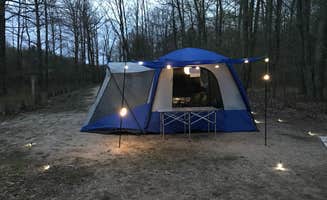Dispersed camping near Sand Lake, Michigan offers rustic backcountry experiences primarily across the Huron-Manistee National Forest. The area features unique sand dunes alongside the Manistee River that create distinctive camping environments rarely found elsewhere in Michigan's lower peninsula. Winter access becomes challenging due to snowfall, with forest service roads often impassable from December through early March.
What to do
Backpacking loop trails: The North Country Trail connects with the Manistee River Trail creating a popular 20-mile hiking circuit through varied terrain. According to one camper who hiked for "five days, four nights," the trail "connects to NCT" and visitors should "bring toilet paper" and water filters as streams provide the main water source.
River activities: The Manistee River provides opportunities for kayaking, swimming, and fishing throughout warmer months. One visitor noted, "you could spend so much time here, climbing around, swimming, kayaking, and enjoying the views," highlighting the Huron-Manistee National Forest water-based recreation options.
Wildlife observation: The forest hosts diverse animal species including white-tailed deer, wild turkeys, and numerous bird species. Campers report regular wildlife sightings, with one noting "lots of wildlife" during their backcountry camping experience, though specific animal encounters vary by season and location.
What campers like
Well-maintained trail systems: Forest trails receive regular maintenance, making navigation straightforward even for less experienced hikers. A camper mentioned the trails are "always so maintained" and "the sites are easy to find and always marked," indicating Huron-Manistee National Forest prioritizes trail upkeep.
Campsite privacy: Dispersed sites throughout the forest provide solitude even during busier seasons. One backpacker noted "the nearest other campers were not within earshot nor could we see them," highlighting the privacy available when camping away from designated areas.
Riverside camping options: Government's Landing provides direct Manistee River access with primitive campsites. A visitor who stayed "at the end of Government's Landing on the river" described it as "amazing" where they "hiked all through the forest" and "discovered a new love for camping and nature."
What you should know
Navigation requirements: GPS systems or offline maps are essential as cell service remains unreliable throughout the forest. One backpacker observed "cell service was spotty, which was the goal," confirming the limited connectivity that requires advance preparation.
Multiple site options: Having several potential camping locations identified before arrival is crucial, especially during peak season. A camper advised to "have at least 3 sites as possibilities" to ensure finding an available spot, particularly important when Huron-Manistee National Forest experiences higher visitor numbers from May through September.
Permit considerations: While many dispersed areas remain free, certain sites or activities may require permits depending on season and location. Always check current regulations with the Forest Service before planning overnight stays.
Tips for camping with families
Child-appropriate backpacking: The trail system accommodates family hiking trips with children carrying appropriate gear. One family trip included "11 Grandkids" where "children all carried their own tents, sleeping bags, and food for 4 days" along the Manistee River trail, which the reviewer described as "absolutely gorgeous."
Water filtration necessity: The Manistee River provides water for cooking and drinking but requires proper filtration. A family camper mentioned the "River trail supplied us with our water needs for cooking and drinking, from the Manistee River," highlighting the importance of bringing filtration equipment.
Wildlife awareness: Teaching children proper food storage and wildlife awareness enhances safety during forest camping. Families should store food in sealed containers and discuss appropriate animal encounter protocols before arriving at Cut River Dispersed Campsite or other forest locations.
Tips from RVers
Size limitations: Most dispersed sites accommodate smaller recreational vehicles but present challenges for larger rigs due to narrow forest roads and clearance issues. Site selection requires advance research.
Dump station planning: No hookups exist at dispersed sites, requiring self-contained waste management. RVers should locate nearby sanitary dump stations before arrival, as the nearest facilities may be 20+ miles from remote camping areas.
Leveling preparations: Forest terrain often features uneven ground requiring leveling blocks and stabilization equipment. Experienced RVers recommend bringing extra leveling materials when camping in the Huron-Manistee National Forest's varied topography.


